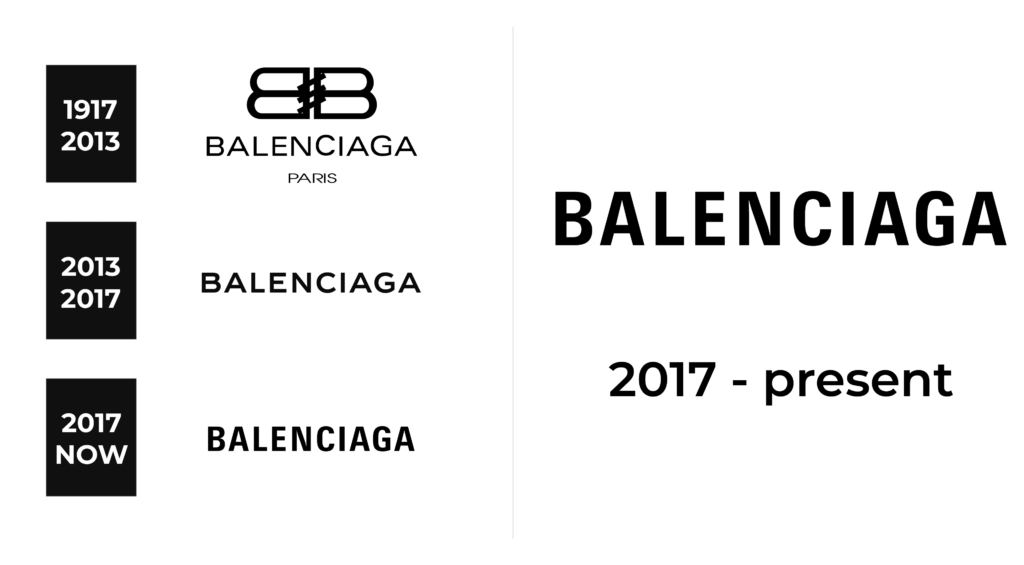Balenciaga Logo
Tags: clothes | fashion house | footwear | luxury clothing
The history of Balenciaga began in 1919 in Spain, when the son of a fisherman and a seamstress, Cristobal Balenciaga, opened a boutique and sewing workshop in the town of San Sebastian. Initially, the designer offered tailoring services to the Spanish aristocracy and members of the royal family.
Meaning and history
The first Cristóbal Balenciaga collection, which was inspired by the Renaissance in Spain, was an instant success in Paris. Two years after his debut, French journalists called Cristobal a fashion revolutionary, and all of his designs were incredibly sought after.
The couturier opened boutiques in Madrid and Barcelona in 1922, and 15 years later a fashion house in the French capital. The conquest of Paris was not easy – the fashion designer did not have enough money for all revolutionary ideas, so he constantly had to borrow them from acquaintances. In 1937, Cristobal Balenciaga presented his first designer collection to Parisians.
In the 1950s, the Balenciaga boutique was the most expensive in Paris, its customers included Jacqueline Kennedy, Elizabeth Taylor, Grace Kelly, and others. The couturier never gave discounts on outfits to anyone, not even regular customers.
In 1968, the fashion designer closed his fashion house, an event that came as a surprise. But 4 years later Balenciaga briefly returned to work, especially to create a wedding dress for socialite Maria Carmen Martinez-Bordue. It took 10,000 pearls and twenty spools of silver thread to embellish the dress. This work was his farewell to the world of fashion and life – in March 1972, two weeks after completing the dress, Cristóbal Balenciaga died of a heart attack.
Balenciaga was closed for almost 20 years until the rights to it were acquired by Jacques Bogart S.A. In 2001, the fashion house was bought by Gucci Group (now Kering).
Since 2015, the Balenciaga brand has been headed by the Georgian-born designer Demna Gvasalia. Gvasalia is a designer who, like the first creator of the brand, tries to get away from the usual silhouettes using hyper volumes and unusual cuts. Today Balenciaga is filled with unusual meanings of outfits, layering, aesthetics of cut, and many other things that are incredibly popular in the world of fashion.
What is Balenciaga?
Balenciaga is one of the iconic luxury clothing brands founded by Cristóbal Balenciaga in 1919. The Spanish-born designer moved to Paris in 1937, creating his fashion house, which today is a symbol of luxury style. The brand produces clothes, footwear, and accessories for men and women.
In terms of visual identity, Balenciaga is quite a minimalistic brand. The fashion house uses a bold sans-serif wordmark in the uppercase as the only element of its logo. If we dig deeper into history, at the very beginning of Balenciaga, its logo consisted of just the designer’s signature. The original logo consisted only of the designer’s surname and the inscription “Maison de Paris”.
1917 – 2013
Since the 1917, the Balenciaga logotype began to appear together with a unique monogram in the form of two mirrored letters “B”, and the additional lettering “Maison de” from the first logo were discarded. The capital “B”s were set in an extended sans-serif font and connected by three bold diagonal lines, resembling three stitches. As for the main logotype, it was written in a modern font with medium-weight lines.
2013 – 2017
The redesign of 2013 has removed the “Paris” tagline and the iconic double-B monogram. The new version of the badge featured just a bold uppercase wordmark, executed in a stable and distinctive sans-serif typeface. The logo was set in a minimalistic black-and-white color palette.
2017 – Today
In 2017 the head designer of the Balenciaga fashion house, Demna Gvasalia, modernized the badge, choosing a new typeface for the uppercase logotype. The lettering became bolder and more compact, with narrowed characters, thick bars, and straight cuts of the lines. It looks more confident than the previous version of the badge and represents the evolution of the brand.
Font and color
The logotype, designed for Balenciaga by Demna Gvasalia, is set in a modern sans-serif typeface with a bit of narrowed contours of the characters. The lettering is executed in the famous Zurich Std Bold typeface but is also very similar to Utah WGL Condensed Bold.
In terms of colors, the Balenciaga badge is super laconic — the brand uses black as its main color, even though the fashion house is known for its brave and sassy color decisions for its collections.





